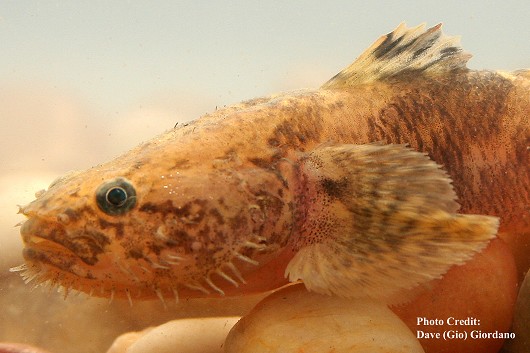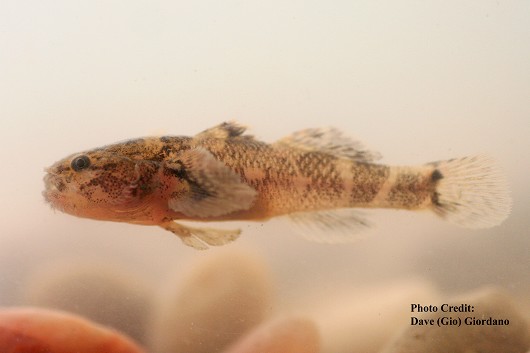Shokihaze Goby
-
Scientific NameTridentiger barbatus
-
NativeNon-Native
-
Identification
 Shokihaze goby, head. Captured in Suisun Marsh, CA on 6 August 2007.
Shokihaze goby, head. Captured in Suisun Marsh, CA on 6 August 2007. Shokihaze goby, captured in Suisun Marsh, CA on 6 August 2007. Length: 5 cm (2 inches).
Shokihaze goby, captured in Suisun Marsh, CA on 6 August 2007. Length: 5 cm (2 inches).- Stout body with blunt snout, and a thick caudal peduncle
- Small eyes close to the top of the head
- Rounded tail
- 2 distinct dorsal fins
- Large, round pectoral fins
- Pelvic fins fused to form a sucking disc
- Numerous small barbels on the head below the eyes and also on the lower jaw
-
Life HistoryThe Shokihaze goby is an invasive species which is native to native to Asia (China, Japan, Korea, Taiwan, Hong Kong). In California it was first discovered in the brackish waters of the San Francisco Bay estuary in 1997. Shokihaze gobies are now common in the waters of Suisun Bay and the lower Sacramento River. They appear to be able to live in a wide range of water depths, water clarities, water salinities, and water temperatures. This goby has been collected at water depths ranging from 2.2 m to 25.9 m visibility (Secchi depth) ranging from 0.15 m to 0.75 m, salinities ranging from 0.09 to 28.81% and temperatures ranging from 7.6°C to 22.3°C.Shokihaze gobies grow rapidly and reach maturity during their first year of life. By age 1 they reach a TL of about 91 mm. The largest size this goby reaches is about 121 mm by age 2.Spawning occurs primarily during spring and summer and ends by August. Females and males ripen simultaneously in April/May for spring spawning and in June/July for summer spawning. The males are ripe when their testes are white and flocculent. Females carry between 4,178 and 20,708 yolked ovarian eggs once they are ripe. The females carry two egg groups: one group of spherical yolked eggs (0.4-0.5 mm in diameter) and a second group of smaller flat, clear eggs (0.04-0.08 mm in diameter). The undeveloped eggs are connected to fibrous material between the yolked eggs. There does appear to be some parental care by males based on aquaria studies.Shokihaze goby are very liberal consumers. Their diet consists of epibenthic and benthic invertebrates. In a California study of 169 individuals, they were commonly found to consume gammarid amphipods, hydrozoa (Cordylophora caspia), polychaetes, copepods, bay barnacles (Balanus improvisus), mysids (Neomysis mercedis, Acanthomysis bowmani, Neomysis kadiakensis), isopods, clam siphons and plants. Less commonly they were found to consume decapoda (Crangon, Palaemon macrodactylus), corophiidae amphipods and arachnida. Very rarely they consumed nematodes, cladocera, cumacea, chironomidae, the bivalve Potamocorbula amurensis, Molgula manhattensis, and longfin smelt (only found to be consumed once).The information above is from research by Steven Barnard Slater (Life history and diet of the Shokihaze Goby Tridentiger barbatus in the San Francisco Estuary. Masters thesis, California State University Sacramento, 2005). Much research has been done regarding the Asian populations of Shokihaze goby. More research is necessary to fully understand the California populations of this species.
-
Links to Other ResearchN / A
-
WatershedN / A
Please note, watersheds are at the USGS 8-digit Hydrologic Unit Code (HUC) scale, so they often include a lot of sub-watersheds. If a species occurs in any sub-watershed within the HUC, the species appears within the HUC. Link to an EPA page that shows HUCs.

